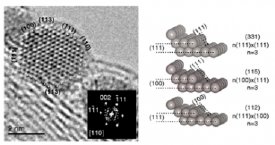Oct 19 2009
Fuel cells, devices that can produce electricity from hydrogen or other fuels without burning them, are considered a promising new way of powering everything from homes and cars to portable devices like cellphones and laptop computers. Their big advantage - the prospect of eliminating emissions of greenhouse gases and other pollutants - has been outweighed by their very high cost, and researchers have been trying to find ways to make the devices less expensive.
 At left, a high-resolution Transmission Electron Microscopy image of platinum nanoparticles on a fuel cell's electrode reveals surface steps that researchers say are responsible for dramatically improving efficiency. These steps are shown in greater detail in the diagram at the right.
Image: Journal of American Chemical Society
At left, a high-resolution Transmission Electron Microscopy image of platinum nanoparticles on a fuel cell's electrode reveals surface steps that researchers say are responsible for dramatically improving efficiency. These steps are shown in greater detail in the diagram at the right.
Image: Journal of American Chemical Society
Now, an MIT team led by Associate Professor of Mechanical Engineering and Materials Science and Engineering Yang Shao-Horn has found a method that promises to dramatically increase the efficiency of the electrodes in one type of fuel cell, which uses methanol instead of hydrogen as its fuel and is considered promising as a replacement for batteries in portable electronic devices. Since these electrodes are made of platinum, increasing their efficiency means that much less of the expensive metal is needed to produce a given amount of power.
The key to the boost in efficiency, the team found, was to change the surface texture of the material. Instead of leaving it smooth, the researchers gave it tiny stairsteps. This approximately doubled the electrode's ability to catalyze oxidation of the fuel and thus produce electric current. The researchers believe that further development of these surface structures could end up producing far greater increases, yielding more electric current for a given amount of platinum.
Their results are reported Oct. 13 in the Journal of the American Chemical Society. The paper's eight authors include chemical engineering graduate student Seung Woo Lee and mechanical engineering postdoctoral researcher Shuo Chen, along with Shao-Horn and other researchers at MIT, the Japan Institute of Science and Technology, and Brookhaven National Laboratory.
"One of our research focuses is to develop active and stable catalysts," Shao-Horn says, and this new work is a significant step toward "figuring out how the surface atomic structure can enhance the activity of the catalyst" in direct methanol fuel cells.
Resolving a controversy
In their experiments, the team used platinum nanoparticles deposited on the surface of multi-wall carbon nanotubes. Lee says that many people have been experimenting with the use of platinum nanoparticles for fuel cells, but the results of the particle size effect on the activity so far have been contradictory and controversial. "Some people see the activity increase, some people see a decrease" in activity as the particle size decreases. "There has been a controversy about how size affects activity."
The new work shows that the key factor is not the size of the particles, but the details of their surface structure. "We show the details of surface steps presented on nanoparticles and relate the amount of surface steps to the activity," Chen says. By producing a surface with multiple steps on it, the team doubled the activity of the electrode, and the team members are now working on creating surfaces with even more steps to try to increase the activity further. Theoretically, they say, it should be possible to enhance the activity by orders of magnitude.
Shao-Horn suggests that the key factor is the addition of the edges of the steps, which seem to provide a site where it's easier for atoms to form new bonds. The addition of steps creates more of those active sites. In addition, the team has shown that the step structures are stable enough to be maintained over hundreds of cycles. That stability is key to being able to develop practical and effective direct methanol fuel cells.
Team members also hope to understand whether the steps enhance the other part of the process that takes place in a fuel cell. This study looked at the enhancement of oxidation, but the other side of a fuel cell undergoes oxygen reduction. Does the addition of steps to the surface also enhance the oxygen reduction? "We need to find why it does, or why it doesn't," Shao-Horn says. The researchers expect to have answers to that question in the next few months.